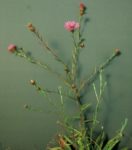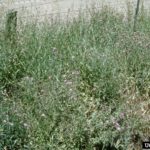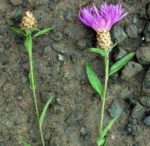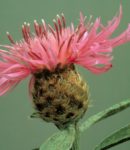Gallery:
- Meadow knapweed
- Meadow knapweed infestation
- Meadow knapweed
- Meadow knapweed flower
Common names:
Meadow Knapweed
Scientific Name:
Centaurea x moncktonii (syns: C. pratensis, C. jacea x nigra, C.nigra var. radiata, C. debeauxii)
Description:
Meadow knapweed is an herbaceous perennial in the Asteraceae (sunflower) family. It is a hybrid between black knapweed (C. nigra) and brown knapweed (C. jacea), and thus it can have variable characteristics. It grows from a taproot and a woody crown. The leaves of the rosette can be lobed or unlobed and are slightly hairy, while the stem leaves are linear or slightly lobed and up to 6 inches long, growing smaller as they near the top of the plant. The lower leaves are longstalked, while the upper leaves have no stalks. Flowers are purple to pink to white and are solitary at the tip of branches. A key-identifying feature is the brown brushy-fringed bracts on the flower head.
Life cycle:
Height of mature plants
3 feet (but varies from 1 to 5 feet)
Flower color:
pink, purple, white
Bloom time:
May – August
Look-a-likes:
Meadow knapweed can be confused with other knapweeds, especially spotted knapweed. However, the bracts on meadow knapweed are brown and papery with fringed bracts. The leaves are also less lobed than spotted knapweed. If you need help with plant identification, please contact your county noxious weed coordinator.
Habitat:
Meadow knapweed can grow in a wide variety of habitats, from fields and prairies to riverbanks and moist meadows. It can also be found growing along roadsides, in forest openings, clearcuts, industrial sites and tree farms.
Impacts:
Meadow knapweed can spread aggressively in pastures and meadows and it will outcompete native plants and desirable forage plants (though sheep find it desirable). Seeds can remain viable in the soil for 5 years, it has a tough perennial root system, and it can resprout from root crowns, making it difficult to control.
Noxious Weed Listing:
- WeedWise: Maintenance
- State of Oregon: Class B
- State of Washington: Class B
- Four County CWMA: Class B
- Columbia Gorge CWMA: Class B
Origin:
Europe
Links:
Oregon Noxious Weed Profile
Washington Noxious Weed Profile
Invasive.org profile
CABI Invasive Species Compendium




